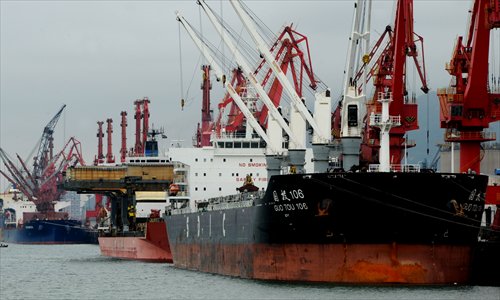Export growth a positive sign: MOFCOM
Improvement set to continue in second half

Ships tied up at Lianyungang Port in East China's Jiangsu Province Photo: CFP
China's 1 percent year-on-year export growth in the first half of 2015 has been a valuable achievement, Shen Danyang, spokesman for China's Ministry of Commerce (MOFCOM), said at a media briefing on Tuesday.
Exports reached $1.07 trillion in the first six months of this year, while imports in the same period dropped 15.5 percent year-on-year to $808.8 billion, according to a press release from MOFCOM.
China has seen higher export growth than other major economies, Shen said, citing data from the WTO showing that the US, South Korea, South Africa and Brazil all reported year-on-year export declines in the first five months of 2015.
Faced with economic difficulties, in both domestic and overseas markets, China's exports have been under pressure since the second half of last year. But there has been an improvement since May, particularly in June, Xu Hongcai, director of the Economic Research Department at the China Center for International Economic Exchanges, told the Global Times on Tuesday.
China's General Administration of Customs said on July 13 that exports rose 2.8 percent in June year-on-year.
The sluggish global economy has resulted in weak demand in overseas markets, according to Shen.
Also, while the exchange rate between the yuan and the US dollar has remained stable this year, some other currencies, including the Japanese yen and the euro, have depreciated against the dollar, leaving Chinese goods less competitive in terms of prices, Shen noted.
Other factors putting pressure on exports include China's increasing labor costs and higher standards for environmental protection at manufacturing enterprises, Xu said.
In addition to the export growth, China's export quality and structure have improved so far this year, Shen said, noting that mechanical and electrical product exports as well as exports from private enterprises have seen robust growth.
He also predicted that China will see better exports data in the second half of 2015 because of the gradual recovery in the global economy, especially in the US.
Liu Xuezhi, an analyst at Bank of Communications in Shanghai, told the Global Times Tuesday that free trade zones in China and new free trade agreements will also encourage trade growth.
In addition to the China (Shanghai) Pilot Free Trade Zone, which was established in 2013, China also launched three new free trade zones in April, in North China's Tianjin, South China's Guangdong Province and East China's Fujian Province.
China also signed free trade agreements with South Korea on June 1 and with Australia on June 16.
Moreover, China's "One Belt, One Road" initiative will encourage outbound investment and exports to related countries, Xu noted.
Growth of exports to countries and regions along the route of the "One Belt, One Road" initiative is higher than average export growth, Shen said, noting that the rise in China's exports to India, Thailand and Vietnam in the first half surpassed 10 percent year-on-year.
To further support exports, China will continue to launch new policies, including facilitating customs clearance, providing assistance to high-tech goods exports, and offering tax benefits, according to Liu.
The State Council's standing committee has also approved a proposal for supporting import and export growth drafted by MOFCOM, Shen said, noting that the new proposal aims to simplify trade procedures and reduce the tax burden for enterprises.